To reduce dark noise in camera sensors, cool your camera with thermoelectric or liquid nitrogen systems—this can cut noise by up to 90%. Use dark frame subtraction by capturing images with the lens cap on, then subtract these from your actual images. Choose shorter exposure times and lower ISO settings whenever possible. Maintain your camera at cooler temperatures since dark current doubles with every 10°C increase. These techniques will transform your low-light microscopy results.
Understanding Dark Current in Microscope Image Sensors
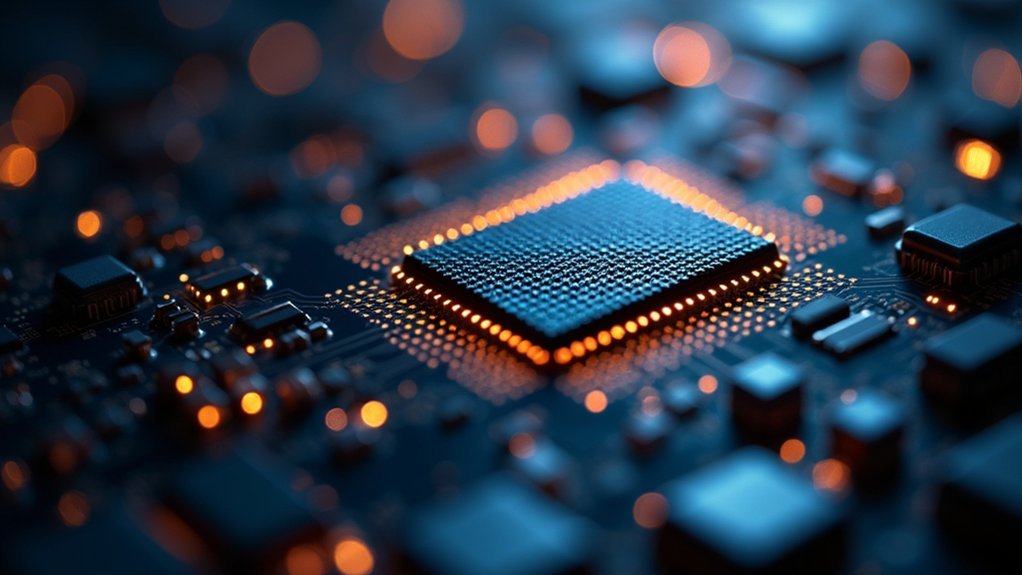
Noise, the persistent enemy of clear imagery, often manifests as dark current in microscope image sensors. This phenomenon occurs when thermal energy generates free electrons in the sensor, creating unwanted signals even in the absence of light.
You’ll notice dark noise particularly in low-light microscopy, where these thermal artifacts can obscure faint specimen details. Temperature plays a critical role—dark current typically doubles with every 10°C increase, making thermal management your primary noise reduction strategy.
To implement effective correction, you need to quantify dark current accurately. Optical black pixels in your sensor serve as reference points, allowing you to measure baseline noise levels.
With this data, you can apply compensation algorithms during signal processing, dramatically improving image quality for your microscopic observations.
The Impact of Temperature on Microscope Sensor Noise
Temperature’s profound impact on dark noise can’t be overstated, as every 10°C increase doubles the dark current in your microscope’s sensor.
You’ll need to compare cooling solutions such as thermoelectric or liquid nitrogen systems to find the ideal thermal management strategy for your specific imaging requirements.
Accurate noise measurement techniques, including dark frame acquisition at controlled temperatures, will help you quantify improvements and identify problematic hot pixels that disproportionately contribute to image degradation.
Temperature Effects Examination
When examining the relationship between thermal conditions and microscope image quality, understanding temperature’s critical role becomes paramount. Your microscope’s sensor generates temperature-dependent dark current that approximately doubles with every 10°C increase, directly elevating thermal noise levels in your images.
| Temperature Change | Dark Current Effect | Recommended Action |
|---|---|---|
| +10°C | Doubles dark current | Implement active cooling |
| +20°C | Quadruples dark current | Consider thermoelectric cooling |
| +30°C | 8x dark current | Utilize liquid nitrogen for critical applications |
You’ll achieve considerably clearer images by controlling your sensor’s thermal environment. For precise microscopy applications, cooling mechanisms are essential investments that will drastically reduce noise interference. By measuring dark current accurately at various temperatures, you can implement appropriate compensation techniques, ensuring peak sensor performance even when environmental conditions fluctuate.
Cooling Solution Comparisons
Because your imaging quality directly depends on sensor temperature management, selecting the right cooling solution becomes essential for noise reduction in microscopy.
Different cooling solutions offer varying levels of dark noise reduction based on their temperature capabilities.
Thermoelectric coolers (TECs) can maintain sensors at -20°C to -40°C, reducing dark noise by up to 90% in high-performance systems. For every 10°C temperature decrease, you’ll effectively cut dark current in half.
For extreme requirements, liquid nitrogen cooling achieves temperatures as low as -196°C, greatly minimizing thermal electron generation.
Your choice impacts more than just dark noise—it meaningfully enhances your signal-to-noise ratio (SNR) and dynamic range, particularly valuable for low-light imaging.
Noise Measurement Techniques
To effectively implement cooling solutions, you’ll need accurate methods to measure and quantify the dark noise in your microscope’s sensor. Start by capturing dark frames with the lens cap secured, ensuring no light reaches your image sensors. Always shoot in RAW format to preserve data integrity during noise measurement techniques.
Create a master dark frame by stacking multiple captures, which helps identify persistent noise patterns and hot pixels—those particularly susceptible to dark current.
Remember that each pixel may respond differently to temperature changes, with dark current typically doubling every 10°C increase.
When evaluating cooling effectiveness, compare dark frames taken at different temperatures to visualize the noise reduction. This comparative analysis will demonstrate how solutions like thermoelectric cooling or liquid nitrogen directly impact your sensor’s noise profile, allowing for informed optimization decisions.
Peltier Cooling Systems for Scientific Cameras
Scientific cameras equipped with Peltier cooling systems offer a powerful solution for photographers and researchers battling dark noise issues.
These thermoelectric coolers utilize the Peltier effect to reduce your camera sensor’s operating temperature by up to 30°C or more, dramatically minimizing dark current—the primary culprit behind dark noise.
By cooling your sensor 30°C below ambient temperature, Peltier systems effectively eliminate the dark current noise that plagues sensitive imaging.
You’ll find these cooling systems particularly valuable in high-sensitivity applications like astrophotography and spectroscopy, where image quality depends on minimal noise interference.
The cooling efficiency you’ll experience depends on ambient temperature, heat dissipation capabilities, and your camera’s housing design.
To maintain peak performance, don’t neglect regular maintenance and proper thermal management of your Peltier-cooled camera.
Without proper care, prolonged use can lead to wear and reduced cooling efficiency over time.
Liquid Cooling Solutions for High-Resolution Microscopy
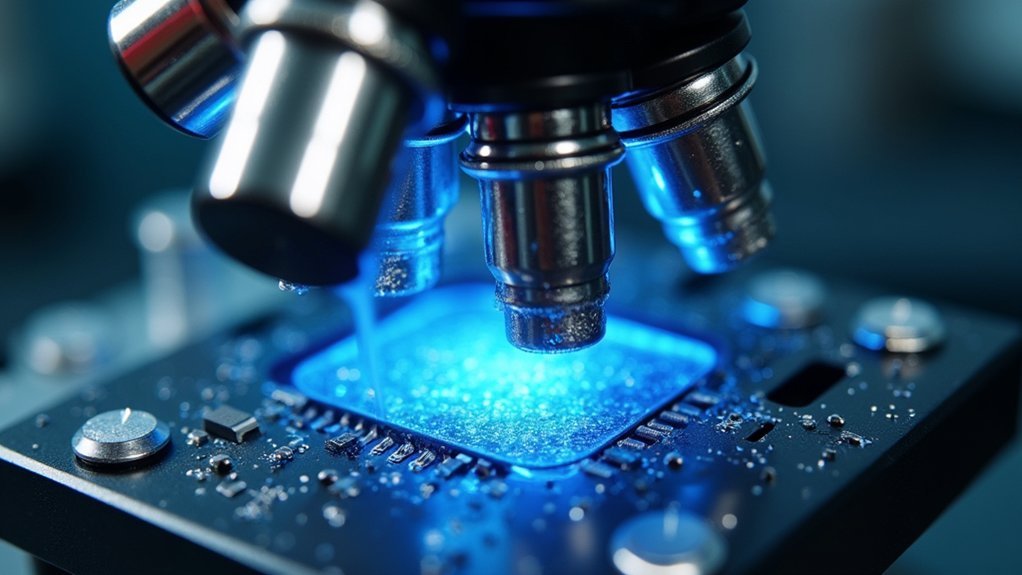
When imaging at microscopic scales where even the faintest signals matter, liquid cooling solutions offer superior thermal management for your camera sensors.
These systems can maintain temperatures as low as -80°C, greatly reducing dark noise that typically doubles with every 10°C increase.
You’ll achieve considerably improved signal-to-noise ratio (SNR) by implementing thermoelectric coolers or circulatory liquid cooling systems. This enhancement allows you to detect previously invisible low-light signals essential for biological and material science applications.
For peak performance, regularly maintain your cooling setup to prevent leaks and temperature fluctuations that could compromise image quality.
With proper implementation, liquid cooling solutions enable you to capture clearer microscopic images by minimizing thermal noise contributions, making the invisible visible in your high-resolution microscopy work.
Dark Frame Subtraction Techniques for Microscope Images
Because microscope sensors inherently generate dark noise even without light exposure, dark frame subtraction provides a powerful solution for cleaner imaging results.
To implement this technique effectively, capture multiple dark frames with your lens cap on, using the same exposure settings and temperature as your actual microscopy work.
Identical exposure settings and environmental conditions ensure your dark frames accurately reflect the noise in your scientific images.
Stack these frames to create a master dark frame that accurately represents your sensor’s noise profile. You’ll want to shoot in RAW format to preserve all data integrity during this process.
When you subtract this master frame from your microscope images, you’ll effectively eliminate fixed pattern noise and greatly enhance your signal-to-noise ratio (SNR).
The result? Your microscope images will display finer details and improved clarity, allowing you to observe specimens with greater precision and accuracy.
Software-Based Noise Reduction for Microscope Photography
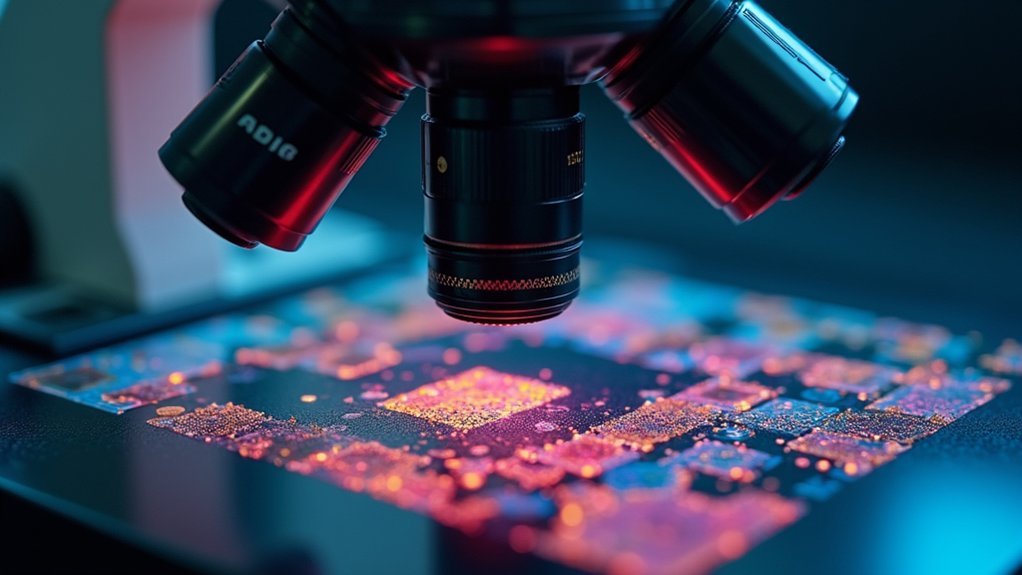
Modern post-processing algorithms can dramatically improve your microscope images by distinguishing actual specimen details from sensor noise.
You’ll find that stacking multiple captures through averaging techniques effectively reduces random noise while preserving critical microscopic structures.
Real-time denoising software gives you immediate feedback on noise reduction parameters, allowing you to optimize image clarity during live microscopy sessions rather than relying solely on post-capture editing.
Post-Processing Algorithms
Although hardware-based solutions offer considerable advantages, post-processing algorithms provide powerful tools for eliminating dark noise in microscope photography. You can implement master dark frame subtraction by stacking multiple dark images taken under identical conditions, effectively mapping and removing noise patterns across your sensor.
For more sophisticated noise reduction, consider Bayesian estimation or convolutional neural networks that intelligently separate actual image data from noise. These approaches considerably improve your signal-to-noise ratio (SNR), resulting in clearer, more detailed images essential for accurate analysis.
Many software solutions allow you to apply temporal averaging across multiple frames, which preserves consistent signals while minimizing random noise fluctuations.
You’ll benefit from adjustable parameters that let you fine-tune noise reduction strength based on your specific microscope’s characteristics, optimizing image quality for your particular needs.
Real-Time Denoising Techniques
Unlike static post-processing methods, real-time denoising techniques offer immediate feedback while you’re capturing microscope images.
These solutions analyze multiple frames simultaneously, averaging out random noise while preserving critical details from your specimen.
Modern real-time denoising techniques greatly improve the signal-to-noise ratio (SNR) of your microscopy work, especially when using CMOS sensors in low-light conditions.
You’ll find both temporal and spatial filtering algorithms that intelligently reduce noise by comparing neighboring pixels and sequential frames.
For enhanced results, try machine learning-based approaches like CNN systems that adaptively learn noise patterns specific to your microscope setup.
Most software platforms offer customizable settings so you can balance noise reduction against detail preservation depending on your application’s requirements—whether you’re examining cellular structures or material samples.
Optimal Exposure Settings to Minimize Dark Noise
When selecting exposure parameters for your photography, understanding how they impact dark noise can greatly improve your image quality.
To achieve ideal exposure settings that minimize dark noise, prioritize shorter exposure times whenever possible. Longer exposures allow more time for dark current to accumulate in your sensor, increasing noise levels in your final image.
Keep exposure times brief to minimize dark noise – lengthy exposures invite more sensor dark current and noisier images.
Lower your ISO setting to reduce the sensor’s sensitivity to noise. This simple adjustment considerably decreases the amount of dark noise recorded during image capture.
Additionally, try shooting when your camera is cooler, as dark current typically doubles with every 10°C temperature increase.
For critical work, consider taking dark frames with your lens cap on before shooting. Later, subtract these frames from your actual images to effectively compensate for dark current noise.
Hardware Modifications for Improved Thermal Management
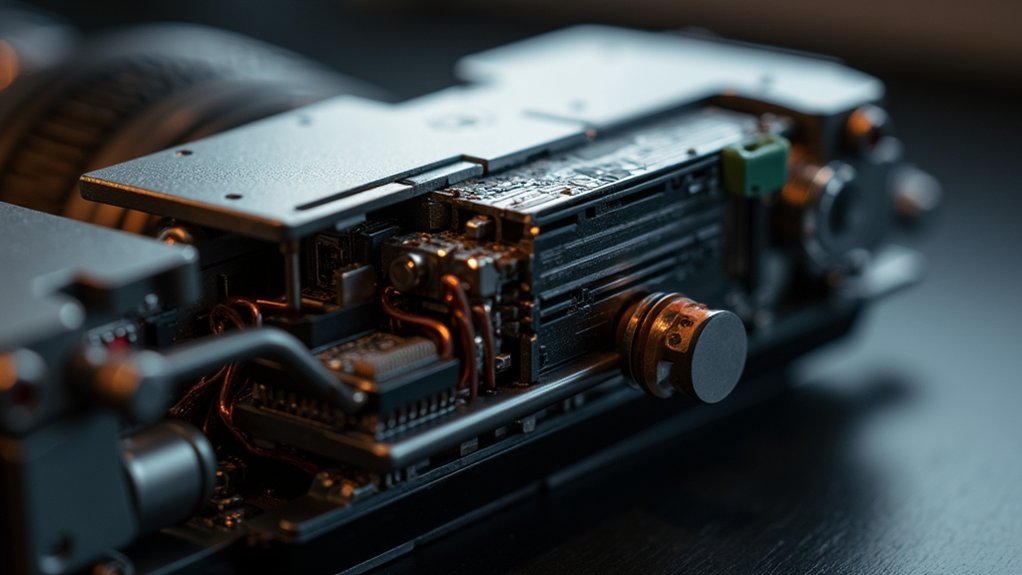
Since thermal energy directly contributes to dark noise generation, implementing effective hardware modifications can considerably improve your camera’s performance.
Consider installing thermoelectric cooling systems that create a thermal gradient, drawing heat away from the sensor and markedly reducing dark noise levels.
You’ll achieve better results by adding heat sinks and thermal conductive materials that enhance heat dissipation from critical components.
For a less complex approach, modify your camera housing to improve airflow and ventilation, which prevents heat buildup around the sensor.
In specialized applications, you might explore liquid nitrogen cooling systems for near-cryogenic temperatures that virtually eliminate thermal-induced dark noise.
Alternatively, look for sensors designed with larger surface areas that naturally dissipate heat more efficiently without requiring additional power consumption.
Comparing Dark Noise Performance Across Camera Models
When you’re evaluating cameras for low-light performance, you’ll need standardized benchmarking methods that compare dark frames at identical ISO, exposure time, and temperature conditions.
Camera sensor architectures vary dramatically in their noise characteristics, with Sony’s Exmor sensors typically outperforming older CMOS designs due to on-chip analog-to-digital conversion.
You’ll notice temperature control creates significant performance differences even between identical models, as dark current doubles with every 10°C increase, making cooling solutions particularly valuable for astrophotography and scientific imaging.
Performance Benchmarking Methods
To accurately compare dark noise performance across different camera models, you’ll need standardized testing protocols that yield measurable, reproducible results.
Start by capturing dark frames at various exposure times while maintaining consistent ISO settings and ambient temperature. Calculate the root mean square (RMS) noise from these frames to quantify dark noise levels numerically.
For valid comparisons, evaluate the signal-to-noise ratio (SNR) under identical conditions across all tested cameras. Test sensors at varying temperatures to understand their thermal characteristics and real-world performance.
Don’t overlook the impact of in-camera noise reduction algorithms—compare raw outputs with and without processing to assess their effectiveness.
These performance benchmarking methods provide objective data that help you determine which camera will deliver cleaner images in low-light situations where dark noise becomes most problematic.
Sensor Architecture Differences
Beyond benchmarking methods, the architecture of a camera’s sensor fundamentally shapes its dark noise profile. When you’re selecting camera equipment, understanding these differences becomes critical for achieving cleaner images.
CCD sensors typically deliver lower dark noise than CMOS alternatives, especially when coupled with cooling systems. Remember that dark current doubles with every 10°C increase, which is why thermal management is integral to sensor architecture design.
| Sensor Type | Dark Noise Level | Cooling Method | Image Processing Edge |
|---|---|---|---|
| Standard CMOS | Moderate to High | Passive | Basic compensation |
| Cooled CCD | Very Low | Thermoelectric | Precise dark frame subtraction |
| Premium CMOS | Low | Active heat sink | Real-time noise reduction |
| Scientific CCD | Extremely Low | Liquid nitrogen | Optical black pixel referencing |
Look for models with optical black pixels, as they provide superior reference points for dark noise reduction during image processing.
Temperature Control Effects
Despite advances in sensor technology, temperature remains the single most critical factor affecting dark noise performance across camera models.
When you’re comparing cameras, understanding their thermal management systems is essential, as dark current doubles with every 10°C temperature increase.
The most effective dark noise reduction strategies include:
- Thermoelectric cooling – High-end models employ active cooling to maintain ideal sensor temperatures.
- Optical black pixel implementation – Premium cameras use these to measure and compensate for temperature-related dark current variations.
- Adaptive noise reduction algorithms – Advanced models adjust processing based on detected temperature fluctuations.
- Thermal isolation design – Better-performing cameras physically separate heat-generating components from the sensor.
Camera models with superior temperature control consistently deliver cleaner images in low-light situations, making thermal management a key differentiator when evaluating camera performance for challenging shooting conditions.
Practical Applications of Cooled Sensors in Microscopy Research
Microscopy researchers have revolutionized their field by implementing cooled camera sensors that dramatically reduce dark noise problems. When you’re working with specimens in low light conditions, these cooling systems can decrease dark current levels by approximately 50% for every 10°C reduction in temperature.
This significant improvement in signal-to-noise ratio (SNR) allows you to capture clearer images with less interference. Thermoelectric cooling systems reaching temperatures as low as -100°C are especially valuable in fluorescence microscopy, where you need to detect weak signals from your samples.
You’ll find that cooled sensors enable longer exposure times without compromising image quality, which is critical when examining faint biological specimens. By implementing this technology, you’ll overcome one of the biggest challenges in microscopy: maintaining image clarity under challenging lighting conditions.
Future Developments in Microscope Sensor Technology
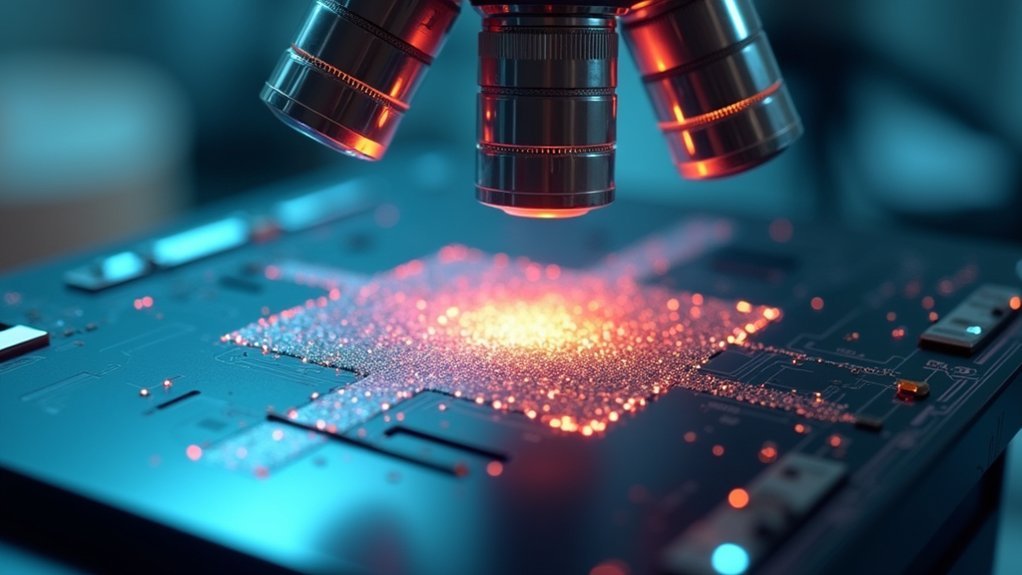
The next frontier in dark noise reduction extends well beyond today’s cooling technologies.
The battle against dark noise is breaking free from cooling’s limitations, ushering in revolutionary detection capabilities.
You’ll soon see sensors with dramatically improved dynamic range through innovative approaches that target multiple noise sources simultaneously.
Emerging technologies to watch:
- Advanced thermoelectric and liquid nitrogen cooling systems that operate at ultra-low temperatures, virtually eliminating thermal contributions to read noise
- Novel pixel architectures with high-efficiency photodiodes specifically designed to minimize photon shot noise effects while maximizing sensitivity
- Real-time machine learning algorithms that can identify and compensate for dark noise patterns during image acquisition
- Quantum dot and perovskite-based sensors that fundamentally alter how electrons are captured and measured, reducing inherent noise floors
These developments will revolutionize your microscopy work, especially for dynamic observations requiring both speed and precision.
Frequently Asked Questions
How Do You Reduce Noise in a Sensor?
To reduce sensor noise, you’ll need to lower your camera’s temperature, capture dark frames for subtraction, utilize optical black pixels, implement cooling systems, and shoot in RAW format for better post-processing results.
How to Reduce Noise in Dark Photos?
To reduce noise in dark photos, you’ll get better results by shooting in RAW, capturing dark frames for subtraction, using cooling techniques, limiting exposure time, and applying specialized noise reduction algorithms during post-processing.
What Is the Dark Noise in the Camera?
Dark noise is the electronic interference in your camera’s sensor caused by thermal energy that generates unwanted electrons. It’s most noticeable in low-light photos, appearing as random colored specks that reduce image quality.
What Causes Camera Sensor Noise?
Your camera’s sensor noise is caused by thermal electron generation, dark current that doubles every 10°C, fixed pattern variations, hot pixels, cosmic rays, radiation, and high ISO settings that amplify these imperfections.
In Summary
You’ve now seen how temperature control, cooling systems, and post-processing methods can dramatically reduce dark noise in your microscope imaging system. By implementing these techniques, you’ll capture clearer images with improved signal-to-noise ratios. Whether you’re using dark frame subtraction or investing in Peltier cooling, these approaches will enhance your microscopy results. As sensor technology advances, you’ll continue to benefit from even lower noise floors.

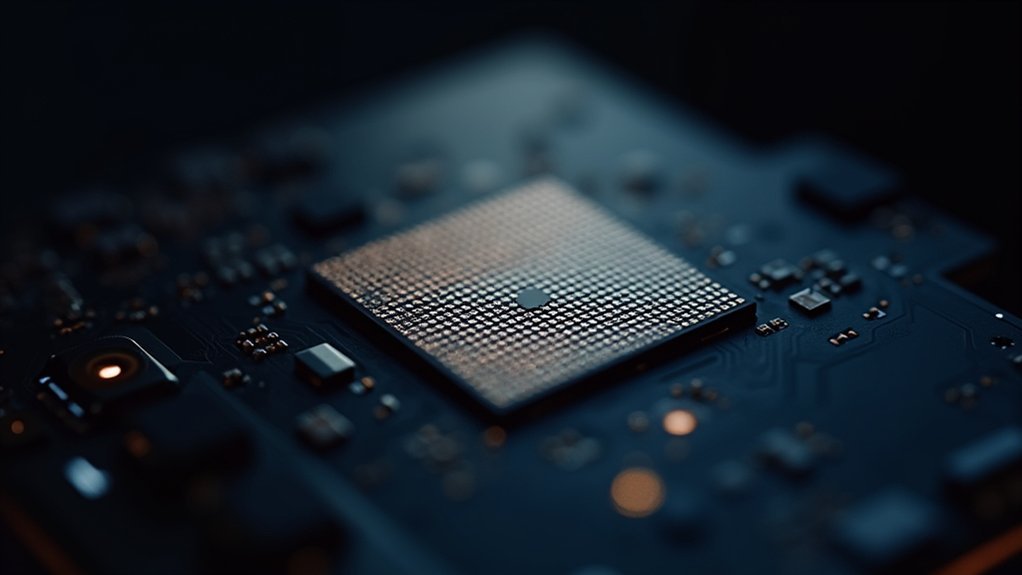



Leave a Reply